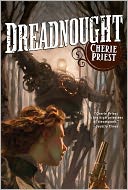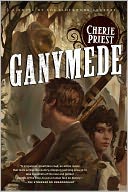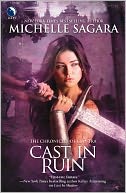 I snagged a copy of Dreadnought by Cherie Priest from the Tor booth at ALA Midwinter. (Many publishers give their books away the last day of the show.) Boneshaker, the first book in Cherie Priest’s Clockwork Century series was one of those books that after reading you sort of shove at people with the admonition “you just have to read this.” Boneshaker was one of the books that makes steampunk so cool.
I snagged a copy of Dreadnought by Cherie Priest from the Tor booth at ALA Midwinter. (Many publishers give their books away the last day of the show.) Boneshaker, the first book in Cherie Priest’s Clockwork Century series was one of those books that after reading you sort of shove at people with the admonition “you just have to read this.” Boneshaker was one of the books that makes steampunk so cool.
Back to Dreadnought. I picked up the print copy for my airplane book. I loved Boneshaker (and Ms. Priest’s paranormal/urban fantasy Bloodshot as well) so I knew Dreadnought would be awesome. I just couldn’t figure out why I didn’t already have it.
Embarrassing answer: I did already have it, in my B&N Nook app on my iPad. Which didn’t solve the airplane problem. I still needed a print book for the dreadful “please turn off all electronic devices” moments. Airline magazines are generally dull as ditchwater, and I can’t sleep on airplanes unless I’m beyond comatose.
So I realized I’ve had Dreadnought for over a year, but it got caught in the “so many books, so little time” vortex. The airplane gave me a chance to return to a writer I enjoyed and her carefully crafted steampunk universe.
Thank you Tor, and thank you ALA trip! I loved Dreadnought. It reminded me of everything I enjoyed about the Boneshaker universe, but it didn’t rely on it too much. Which was a great thing, because I remembered the big story but not the small details, since I read Boneshaker when it came out in 2009. And now I want to read it again.
In the Clockwork Century, the Klondike Gold Rush did happen, But Russian investors paid inventor Leviticus Blue of Seattle to construct a steam-powered mining machine. And history went down a very different path then the one we know. Because Levi Blue’s “Boneshaker” didn’t just destroy a whole lot of downtown Seattle, it also unearthed a terrible gas that turned anyone who breathed it into a zombie. And the stuff was addictive in the bargain, so folks ended up hooked on it before they turned into the “living dead”.
But it was effectively knocking Seattle out of the U.S. economic and political picture on the eve of the U.S. Civil War that was felt back East. That War between the States didn’t wrap up in 1865, it kept going, and going. Five years, ten years, twenty years later, it’s still going on, to the point where grievances aren’t fresh, they’re inherited from fathers and brothers. And that’s where Dreadnought begins. In a Confederate hospital, with a nurse named Mercy Lynch.
Mercy receives two pieces of news, one right on top of another. She gets a visit from the famous nurse Clara Barton, who does found the Red Cross in seemingly every universe. Miss Barton was accompanied by a Union soldier who was given permission to cross the Confederate lines after he had been released from Andersonville Prison. That infamous place also existed. Mercy Lynch and her husband were from Border states. When her husband’s Kentucky home went Union, he enlisted with the Union Army. This Union soldier has come to tell her that he witnessed her husband’s death at Andersonville.
When Mercy was left alone, she became a nurse, and a damn good one. But Mercy was from Virginia. And Virginia was a Confederate State.
After getting the news that she was a widow, Mercy received a telegram from Seattle. Her father was dying and wanted to see her. Mercy didn’t know whether to be astonished or angry. Her father had abandoned her and her mother when she was a child, and had disappeared out West. Mercy hadn’t known he was still alive. But he wanted to see her. Seattle was a long way from Virginia. She would need to quit her position as a nurse and travel thousands of miles by airship and train. The war was between her and the coast.
Mercy felt torn by duty, but also free of duty. And she was tired of being pulled in every direction every minute. After a lot of soul searching, she set out for Seattle.
The journey is an incredible adventure. Dreadnought is a road novel, but the road is like no road story you’ve ever read. It’s not just that everything that can go wrong, does go wrong, it’s also that the kind of things that go wrong are nothing Mercy, or the reader, can possibly imagine.
Most people back East don’t know what has happened in Seattle, so Mercy doesn’t know what she is headed towards. Her world is the War. In Seattle, the War is far away. Their problem is the blight gas. And yes, those two problems do collide, multiple times, on Mercy’s trip, but not in the way you might think.
And wow, what a ride! You just know that when Mercy reaches her destination, her adventure has just begun.
Escape Rating A+: I forgot I was on a plane. I got so sucked into the story, I lost track of everything around me. Mercy Lynch is an absolutely unforgettable character, and the reader is pulled along with her every step and mile of the trip.

 Dreadnought made me want to go back and read Boneshaker again, and read the next book in the series, Ganymede immediately, because I want to find out what happens next. (There’s also a loosely linked novel, Clementine sorta/kinda before Ganymede.) I’m trying to restrain myself, and it’s just about driving me crazy. Dreadnought had me on the edge of my seat. If you like steampunk, read the Clockwork Century and find out what all the fuss is about. You’ll be glad you did.
Dreadnought made me want to go back and read Boneshaker again, and read the next book in the series, Ganymede immediately, because I want to find out what happens next. (There’s also a loosely linked novel, Clementine sorta/kinda before Ganymede.) I’m trying to restrain myself, and it’s just about driving me crazy. Dreadnought had me on the edge of my seat. If you like steampunk, read the Clockwork Century and find out what all the fuss is about. You’ll be glad you did.







